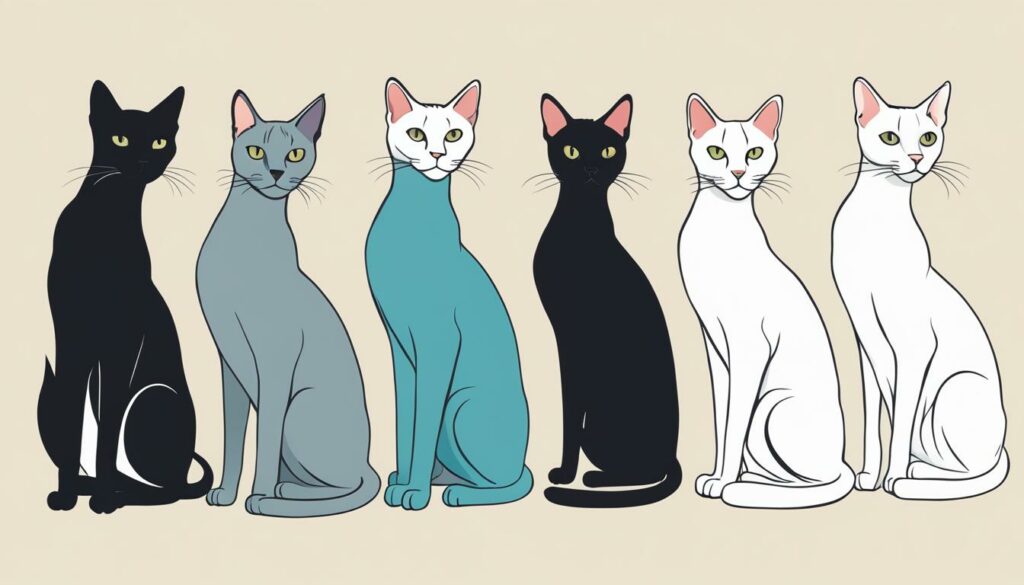Are you a cat lover but struggle with allergies? Don’t worry, there are cat breeds out there that are hypoallergenic and can be your perfect furry companion. Hypoallergenic cat breeds produce fewer allergens, making them a great choice for people with allergies who still want to enjoy the love and companionship of a cat. While no cat breed is completely hypoallergenic, these breeds are known to produce lower levels of the Fel d 1 protein, the main allergen for cat allergies.
Key Takeaways:
- Hypoallergenic cat breeds are a great option for individuals with allergies.
- These breeds produce fewer allergens and have lower levels of the Fel d 1 protein.
- No cat breed is completely hypoallergenic, but some breeds are more allergy-friendly.
- The top 5 hypoallergenic cat breeds are Bengals, Cornish Rex and Devon Rex, Russian Blue, Balinese, and Siberian.
- Choosing a hypoallergenic cat breed can significantly reduce the risk of triggering allergies.
Bengals
When it comes to hypoallergenic cat breeds, Bengals are a popular choice for allergy sufferers. These allergy-friendly cats produce less of the Fel d 1 protein compared to many other breeds, making them a suitable option for people with allergies.
Aside from their lower levels of allergens, Bengals also shed less hair, which further reduces the spread of allergens in your home. This is great news for those who want to enjoy the company of a cat without triggering their allergies.
But what sets Bengals apart is their unique love for water. They enjoy being around and playing with water, and some owners have even reported their Bengals hopping into the shower with them! This playful nature makes Bengals an entertaining and delightful addition to any household.
To summarize, Bengal cats are hypoallergenic due to their lower production of the Fel d 1 protein and reduced shedding of hair. They also have a fun-loving personality that adds an extra element of joy to their presence.
| Pros | Cons |
|---|---|
| Produce less Fel d 1 protein | May be more active and require additional exercise |
| Shed less hair | May be territorial and require proper socialization |
| Enjoy playing with water | Need mental and physical stimulation to prevent boredom |
Pros:
- Produce less Fel d 1 protein
- Shed less hair
- Enjoy playing with water
Cons:
- May be more active and require additional exercise
- May be territorial and require proper socialization
- Need mental and physical stimulation to prevent boredom
Cornish Rex and Devon Rex
Both Cornish Rex and Devon Rex are curly-coated cat breeds that shed very little hair, making them hypoallergenic options for allergy sufferers. The Cornish Rex has a single bottom undercoat, which sets it apart from other cats with three layers of coat. This breed is incredibly soft and velvety. On the other hand, the Devon Rex has all three layers of coat but still produces less allergens and is known for its playful and intelligent personality.
Comparison of Cornish Rex and Devon Rex
| Features | Cornish Rex | Devon Rex |
|---|---|---|
| Coat | Single bottom undercoat | All three layers of coat |
| Shedding | Minimal | Minimal |
| Allergens | Less production of allergens | Less production of allergens |
| Temperament | Soft, velvety, playful | Playful, intelligent |
“The Cornish Rex has a unique coat that is incredibly soft and velvety. It feels like petting a warm, plush toy. On the other hand, the Devon Rex has a coat that is equally captivating, but with a slightly different texture. Both breeds are known for their minimal shedding and reduced allergen production, making them ideal for individuals with allergies.” – Cat Lover Magazine
Russian Blue
The Russian Blue cat breed is a great choice for individuals with cat allergies. Despite their dense coat, Russian Blues are considered hypoallergenic due to their low shedding and minimal production of the Fel d 1 protein, the main allergen for cat allergies. These elegant and beautiful cats not only make stunning companions but also offer relief for those with sensitivities.
Intelligent and Graceful Companions
Russian Blue cats are not only known for their hypoallergenic qualities but also for their high intelligence and friendly nature. These cats are quick learners and enjoy engaging with their owners. Their graceful strides and striking green eyes make them a delightful addition to any household.
The Perfect Bonding Companions
One of the standout qualities of Russian Blues is their unique ability to form strong bonds with their owners. They are known to follow their owners everywhere, making them loyal and affectionate companions. Whether you’re working from home or relaxing on the couch, a Russian Blue cat will always be by your side, providing constant love and companionship.
Reducing Allergens with Russian Blues
Russian Blue cats produce less of the Fel d 1 protein compared to other breeds, which significantly lowers the allergen levels in the home. This makes them an excellent choice for individuals who want to enjoy the company of a cat without suffering from severe allergies. With their low shedding and hypoallergenic qualities, Russian Blues can bring joy and comfort to households with allergy sufferers.
The Key Features of Russian Blue Cats
- Low shedding
- Minimal production of Fel d 1 protein
- Beautiful and elegant appearance
- High intelligence
- Loyal and affectionate
Balinese
Balinese cats, sometimes referred to as “long-haired Siamese,” are a popular choice among cat enthusiasts. Known for their stunning looks and elegant demeanor, Balinese cats are more than just a pretty face. They are highly intelligent, adaptable, and social, making them great companions for families.
Despite their long coats, Balinese cats are considered hypoallergenic due to their lower production of the Fel d 1 protein. This protein is the main allergen responsible for triggering allergic reactions in sensitive individuals. Balinese cats shed less and produce fewer allergens, making them a suitable option for cat lovers with allergies.
Not only are Balinese cats hypoallergenic, but they also have a loving and affectionate nature. They enjoy spending time with their human companions and get along well with children and other pets. Their friendly and social personalities make them a great addition to any household.
Why Choose a Balinese Cat?
Here are some compelling reasons to consider adding a Balinese cat to your family:
- Intelligence: Balinese cats are highly intelligent and quick learners. They enjoy interactive toys and games that challenge their minds.
- Adaptability: Balinese cats are known for their adaptability to different environments. They can easily adjust to new surroundings and routines.
- Affectionate: Balinese cats form strong bonds with their owners and thrive on human interaction. They enjoy being part of the family and will often seek out cuddles and affection.
- Social: These cats are social butterflies and love to be in the company of their human companions. They will happily greet visitors and make new friends.
- Vocal: Balinese cats are known for their soft and melodic voices. They are not overly vocal like some other breeds, but they will communicate with their owners through gentle meows and trills.
- Playful: Balinese cats have a playful nature and enjoy interactive playtime with their owners. They have a natural curiosity and love exploring their surroundings.
Overall, Balinese cats offer a perfect blend of beauty, intelligence, and hypoallergenic qualities. Whether you’re a cat lover with allergies or simply looking for a loving and charismatic feline companion, the Balinese breed is certainly one to consider.
| Breed | Coat Length | Fel d 1 Production |
|---|---|---|
| Balinese | Long | Low |
Siberian
When it comes to hypoallergenic cat breeds, Siberian cats are an unexpected but delightful addition to the list. Despite their beautiful long coat, Siberians are known for being low allergen cat breeds. They produce fewer allergens, including the Fel d 1 protein, compared to other breeds, which makes them a great choice for individuals with allergies.
Not only are Siberian cats hypoallergenic, but they also possess other desirable qualities that make them suitable for families. These intelligent and gentle felines have a knack for adapting well to different environments, ensuring a smooth transition into any home. Whether you have children or other pets, Siberians are known for their friendly and sociable nature, making them wonderful companions.
With their stunning appearance, hypoallergenic qualities, and adaptable personalities, Siberian cats are a perfect choice for individuals who want to enjoy the companionship of a feline friend without the worry of triggering allergies.
Other Hypoallergenic Cat Breeds
In addition to the top 5 hypoallergenic cat breeds mentioned above, there are several other cat breeds that are known for having minimal allergens. These include Oriental cats, Javanese cats, Sphynx cats, Burmese cats, and Ocicat cats.
✨ Oriental cats have short coats and shed very little.
| Breed | Coat Length | Shedding |
|---|---|---|
| Oriental | Short | Minimal |
✨ Javanese cats have low shedding and minimal allergens.
| Breed | Coat Length | Shedding |
|---|---|---|
| Javanese | Medium-Long | Low |
✨ Sphynx cats, despite being hairless, still produce dander, but it can be minimized through regular bathing.
| Breed | Coat Length | Shedding |
|---|---|---|
| Sphynx | Hairless | Low |
✨ Burmese cats have short, silky coats and are on the lower end of the shedding spectrum.
| Breed | Coat Length | Shedding |
|---|---|---|
| Burmese | Short | Minimal |
✨ Ocicat cats have short coats and are considered low-shedding.
| Breed | Coat Length | Shedding |
|---|---|---|
| Ocicat | Short | Minimal |

Understanding Cat Allergies
When it comes to cat allergies, understanding the underlying causes is essential. Cat allergies are primarily triggered by the Fel d1 protein, which is secreted from cats’ skin and saliva. It is this protein that often leads to allergic reactions in sensitive individuals.
All cats produce Fel d1 protein, but the levels of production can vary among different breeds and individual cats. Male cats typically produce less Fel d1 after they have been neutered, while female cats generally produce less than males overall.
Cat allergies can manifest in various symptoms, including sneezing, wheezing, and swollen, itchy eyes. It’s important to note that cat hair itself is not the main cause of allergies; rather, it’s the protein on the hair that triggers allergic reactions in susceptible individuals.
Understanding the role of Fel d1 protein and its presence in different cat breeds is crucial for individuals with allergies to make informed decisions about pet ownership. By choosing a cat breed that produces lower levels of Fel d1 protein, allergy sufferers may be able to minimize their symptoms and enjoy the companionship of a cat without the discomfort that often accompanies allergic reactions.
Can Cats be 100% Hypoallergenic?
No cat breed is 100% hypoallergenic because all cats produce the Fel d 1 protein. However, some breeds are considered hypoallergenic because they produce fewer allergens and have lower levels of the Fel d 1 protein. The amount of Fel d 1 production can vary among different breeds and individual cats, but there is no breed that is completely allergen-free.

Tips for Reducing Allergens in the Home
Even with hypoallergenic cat breeds, it’s still important to take steps to reduce allergens in the home. By implementing these tips, you can create a more allergy-friendly environment for yourself and your family.
1. Keep Your Cat Out of the Bedroom
Designate your bedroom as a cat-free zone. This will help minimize contact with cat allergens while you sleep, ensuring a more restful night’s sleep.
2. Use Pillow and Mattress Covers
Cover your pillows and mattress with allergen-proof covers. These covers create a barrier between you and the allergens that may be present in your bedding.
3. Place Covers over Upholstered Furniture
Add protective covers to your upholstered furniture to prevent cat hair and dander from accumulating on the fabric. These covers can easily be removed and cleaned, reducing the amount of allergens in your living space.
4. Remove or Reduce Carpets
Carpets can trap and hold allergens, making it difficult to keep your home allergen-free. Consider replacing carpets with hardwood or laminate flooring, which is easier to clean and less likely to harbor allergens.
5. Create Extra Ventilation
Improve the airflow in your home by opening windows or using fans to circulate air. Increased ventilation can help remove allergens from the air and reduce their concentration.
6. Clean the House Regularly
Frequent cleaning is essential for reducing cat allergens in the home. Vacuum carpets and furniture regularly using a vacuum cleaner with a HEPA filter. Dust surfaces with a damp cloth to trap allergens effectively. Additionally, wash bedding and curtains regularly to remove any accumulated allergens.
By following these tips, you can significantly reduce cat allergens in your home and create a more comfortable living environment for those with cat allergies.
| Allergen Reduction Tips |
|---|
| Keep your cat out of the bedroom |
| Use pillow and mattress covers |
| Place covers over upholstered furniture |
| Remove or reduce carpets |
| Create extra ventilation |
| Clean the house regularly |
Conclusion
When it comes to cat allergies, choosing a hypoallergenic cat breed can make a world of difference. While no cat breed can guarantee a completely allergy-free experience, hypoallergenic cat breeds are known for producing fewer allergens and shedding less hair, reducing the risk of triggering allergies. The top 5 hypoallergenic cat breeds – Bengals, Cornish Rex and Devon Rex, Russian Blue, Balinese, and Siberian – are excellent options for individuals with cat allergies.
It’s important to note that individual reactions to allergens can vary, so spending time with different cat breeds can help determine how your body responds. This way, you can find a breed that suits you best. Additionally, taking steps to minimize cat allergens in the home can further alleviate allergies for cat owners. Simple measures like keeping your cat out of the bedroom, using pillow and mattress covers, and regular cleaning to reduce dander and fur buildup can make a significant difference.
By choosing a hypoallergenic cat breed and implementing strategies to minimize allergens, individuals with cat allergies can enjoy the companionship and joy that cats bring into their lives, without suffering from allergic reactions. So, if you’re an allergy sufferer who has always wanted a feline friend, consider one of the hypoallergenic cat breeds mentioned above, and take proactive steps to create a comfortable and allergy-friendly environment in your home.







